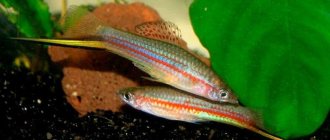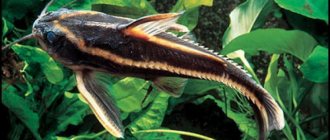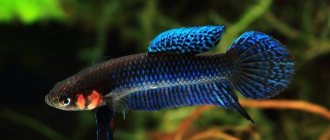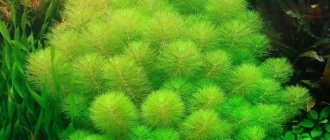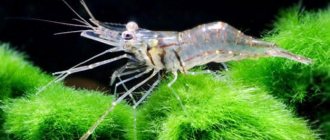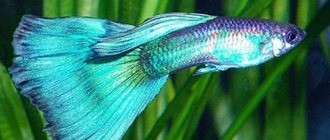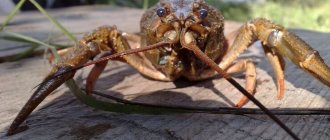The swordtail came from Central America, where it lives in almost all waters. It was also noticed near Yucatan, but without the skillful work of breeders it would still have had an unsightly appearance: an olive body color with a steely sheen. Nowadays you can buy a swordtail aquarium fish in any bright colors: red, black and blue, green, with spots in the tail area and others.
Appearance and structure
Swordtails with a red color and a caudal fin with one elongated ray painted black can be called the “classic” and most recognizable aquarium variation. In an aquarium, fish grow up to 8-10 cm.
In nature, swordtails have a rather modest color - their body is brownish-greenish or yellowish. However, as a result of many years of breeding work, it was possible to develop many varieties of them, distinguished by a variety of colors. The fish can be red, black, yellow, spotted, etc.). The bred forms also differ in fins - in addition to the standard form, there are also veil ones. There are also forms with two rays on the caudal fin.
Female swordtails are larger than males. Males have a gonopodium, a copulatory organ through which fertilization of the female occurs. Males have a silver stripe running along their body, and the sword sometimes has a black edge.
An interesting fact is that under certain conditions, females can change sex to the opposite.
Round-headed swordtail
It is distinguished by a high rounded forehead and a large dorsal fin, similar to a fan. Males do not have a sword at all, or instead have a tiny appendage. The size of the fish is 5-7 cm.
Also a natural variety that came to us from tropical rivers. The color of the scales is silver with a pinkish tint, and there are transverse gray stripes along the body. The dorsal fin of females is gray with dark speckles, while that of males is bright yellow. The remaining fins and tail are colorless.
The requirements for maintenance and feeding are the same as for the Alvarez swordtail, the only peculiarity of the species is that there should be at least twice as many girls as boys.
Habitat
The homeland of swordtails is Central America. They are found in bodies of water in countries such as Mexico, Honduras and Guatemala.
It is noteworthy that their endurance and ability to adapt allows them to live in a wide variety of biotopes: in slowly flowing small rivers, in mountain rivers with strong currents, and even in wetlands and stagnant lakes. Moreover, today they have spread in nature and beyond their natural range. Swordtails are found in the waters of India, Africa, the USA and even the UK.
The species has become invasive in some regions, threatening natural biodiversity. And the reason for this is the person himself. Aquarists provoked this situation by releasing swordtails into natural conditions in their countries.
Sex differences
In this matter, everything is “transparent” and there are no secrets - only the male has an extension in the tail - the so-called “sword”. In addition, like other viviparous fish, the anal fin in females is widened, while in males it is pointed.
There is one amazing phenomenon, the nature of which scientists have not fully understood. Sometimes females grow a sword and begin to act like males, courting the females assiduously! Naturally, in this case we are not talking about any offspring.
Conditions of detention
Swordtails belong to the so-called “harem” fish. It is optimal to keep 2-3 females per 1 male in one aquarium. If you decide to keep several males, then you need to arrange shelters in the aquarium where weaker males can hide from the attacks of their relatives. Under optimal conditions, life expectancy reaches up to 5 years.
Aquarium
For a group of swordtails of 3-4 individuals, of which one is a male and the rest are females, you will need an aquarium of 50 liters or more. Fish are characterized by mobility and jumping ability, so it is necessary to provide the aquarium with a lid.
About water
It is recommended to take care of high-quality water filtration and good oxygen saturation. The optimal temperature for keeping swordtails is 20-28°C, water hardness is in the range of 9-19° dGH and pH = 7.0-8.0, but these fish do not really like frequent water changes in the aquarium, 25-30% of the aquarium volume It is recommended to replace it once every one to two weeks. You need to take into account the majority of the population of the aquarium, because for most tropical fish, replacing once a week is usually the norm, but swordtails do not like this.
Some aquarists periodically, both for medicinal purposes and for prevention, add a little salt to the water - a concentration of up to 1 g/l. Provided that there are no other fish species living with the swordtails that could be harmed by salt.
What is the best soil to choose?
The choice is not important - any will do. But swordtails will look more impressive against the background of dark soil.
Vegetation and scenery
Since in nature these fish thrive in dense thickets, similar conditions for their comfort should be created in the aquarium. Use plants: cryptocoryne, vallisneria, echinodorus, etc., the more magnificent, the better.
But thickets should be alternated with space for free swimming. It is also recommended to place natural driftwood at the bottom; they will become an excellent place for the growth of microalgae, the fouling of which swordtails love to feast on.
Other decorations in the form of pots, grottoes, castles, etc., which the fish will use for relaxation, are also welcome.
Equipment
The aquarium should be equipped according to the standard, as for most other types of fish, these are filters (external or internal, depending on the volume of the aquarium), an aerator, a thermostat, a thermometer.
Lighting
Swordtails are not demanding of lighting; diffused lighting is best. It all depends on the population of the aquarium, if there are a lot of plants in it, then the range and intensity should be appropriate.
Hell's Swordsman
Another decorative look. Traditionally the color is black and white, but there are fish with red spots.
The body is silvery-white, shimmering in different shades, the fins are rich black, like the sword, the length of which reaches the size of the fish itself - from 8 to 10 cm.
This species has a lyretail form.
Any fish of a similar “weight category” will be suitable as a neighbor for a black-tailed pet.
Water with the same parameters as for Geller's swordtail is suitable for keeping.
Common types of aquarium swordtails
Aquarium swordtails can be divided into two groups: natural and obtained through selection.
Despite the fact that the natural species of these fish cannot boast of bright original colors, some aquarists take great pleasure in populating their aquariums with them. Among the popular natural forms are swordtails:
Alvarez (Xiphophorus alvarezi)
The most expensive and rare type. The habitat of the blue swordtail (the second name of the fish) is the fast-flowing rivers of Mexico and Guatemala. In the natural environment, life expectancy is approximately two years, the size of an adult reaches 6-7.5 cm. Females are slightly larger in size than males.
The key feature of this species is the longitudinal stripes on the body of red and blue shades (two or three), formed from points merging with each other. The basic color of the fish's body may vary. In this category there are representatives with a red or green ball, spotted color. This species has a rather peaceful disposition. It is best to keep a small group of fish in an aquarium consisting of two males and three females.
Clemencia (Xiphophorus clemenciae)
Habitat: waters of the Sarabia River, Mexico. The adult size is approximately 4–5 cm. The body is mainly colored silver-blue. A distinctive feature of this breed is a characteristic red-orange stripe along the body, as well as a black stripe along the bottom of the abdomen, turning into the caudal fin and outlining the sword.
Representatives of this species are unpretentious, have a peaceful disposition, and get along well with other fish (guppies, gourami, zebrafish). Males can be distinguished by their xiphoid process in yellow or lemon tones. Clemensias are not often seen in aquariums because... This species is difficult to reproduce. In addition, the female gives birth to small offspring.
Pygmy (Xiphophorus pygmaeus)
The small fish barely reaches 5 cm, which is why it is often called the dwarf swordtail. It lives in fast-flowing rivers of Central America, as well as northeastern Mexico. Life expectancy under favorable conditions is 3–6 years. The peculiarity of this species is that females and males are approximately the same size. And sexual dimorphism is expressed in differences in body color. The bright yellow males, which have a brown stripe along the entire body, as well as a small xiphoid process on the caudal fin, are easily distinguishable from the females, which are colored an unremarkable gray shade.
It is important to know that the species has a cocky character, so you need to choose their neighbors very carefully. It is not recommended to keep them with other breeds/species of swordtails.
Montezuma (Xiphophorus montezumae)
The fish species was first discovered in Mexico. Due to their rather high price (the cost per pair can reach $100), they are not often seen in home aquariums. The size of the fish is 4–8 cm. They look very bright and impressive. For their lush dorsal fin of bright color, representatives of this species received the name royal swordtail . The base color of the body can vary from bright yellow to lilac-silver or brown. The body is lilac-silver and may have black spots.
The “sword” of the fish is quite long, its size is approximately the same as the main body. The bottom of the sword is decorated with a black stripe. The fish has a shy disposition, so it is very important to provide numerous hiding spots in the aquarium. It is best to keep one male and a couple of females.
Round-headed swordtail (Xiphophorus birchmanni)
This type of fish looks significantly different from its other relatives. Moreover, it literally does not justify the name “swordtail,” since the males of this species do not have a xiphoid process on the caudal fin. The name “round-headed” was due to its high forehead. What sets these fish apart from other aquarium inhabitants is their gorgeous fan-shaped dorsal fin. This fin is present in both males and females. In females, the entire body and fin are silver-gray in color. In males, the fin is colored lemon yellow. It contains numerous inclusions of black, which makes it even more impressive and beautiful. The fish have a fairly high body, and the entire body is marked with vertical stripes.
The round-headed swordtail has a peaceful and calm disposition. It gets along well in community aquariums. This is a schooling fish and should be kept in groups. But to avoid fights and aggressive behavior between males, it is necessary to provide swordtails with a large space with a predominance of females.
Fish of this species were actively used in breeding work. The result of crossing with poeciliid fish was the appearance of more than 20 new decorative aquarium varieties. They are distinguished by a brighter and more original appearance, significantly different from the color characteristic of natural forms.
Clemensia's Swordbearer
A rare natural species, it lives in the Papaloapan region of Mexico. It is almost never found in amateur aquariums, as it reproduces poorly in captivity.
The fish is small, 4-5 cm. The color is silver with a blue or pink tint and a beige tint on the back; two scarlet lines are clearly visible along the body. The sword is yellow with a black edge; in some representatives it reaches 3.5 cm in length. The girls are painted in the same colors, but paler. The fins of representatives of the species are colorless or yellowish.
Water parameters:
- temperature from +22 to +26 degrees;
- hardness from 3 to 10 dH;
- acidity 7.2-8 pH.
The most popular breeds of aquarium swordtails
Green or common swordtail
This breed was the first to be bred artificially. It is also the most common due to the attractive appearance of the fish and ease of maintenance.
A dark blue stripe runs through the entire body, and the back may have a green, bluish or bluish color. Males have a xiphoid process, which is framed along the top and bottom with black stripes. The average size of the fish is 10-15 cm, with the length of the xiphoid process being at least 1/2 the length of the body.
Red swordtail
It is distinguished by a rich scarlet color that covers the entire body, including the fins and xiphoid process. This color was achieved as a result of repeated crossings with the red platy.
Red swordtails are easy to care for, which has made them very popular among aquarists. Today, breeders have managed to develop a large number of varieties of this breed, differing in the shape of their fins and “swords”.
Black swordtail
Bred by crossing the green swordtail and black platies. The body has a basic black color, sometimes with minor green or yellow inclusions. The fins are uncolored, and the xiphoid process can be yellow, green, white or black. There are also colorless, like fins, processes. Very sensitive to oxygen and nitrate content in water.
Lemon swordtail
An albino variety of green swordtail. The entire body, fins and “sword” are yellowish in color. In rare cases, the xiphoid process may have a black border.
Calico Swordtail
The result of crossing tiger and red swordtails. The color turned out to be very original and unusual. But breeders have still not been able to completely stabilize the result. Only a small percentage of fry receive the desired tricolor coloration from their parents. The body of this breed of fish has a basic silver-white color with numerous black and red markings and inclusions.
Bulgarian white swordtail
Another variation of the albino swordtail. The main part of the body is transparent, but the front part, eyes and head are scarlet. The breed is characterized by endurance and good survival rate. The fish have a peaceful nature, which makes them comfortable neighbors in shared aquariums.
Black and White (Hell's Swordbearer)
It has a very impressive appearance, thanks to the combination of blue and red tints on a white body, which change depending on the lighting. But individuals with black and white coloring, as stated in the name of the breed, are quite rare. The length of the xiphoid process in males can vary greatly - from 5 mm to the length of the entire body.
Cuban swordtail
The main body color is red, with large black spots scattered on the lower and back parts of the body. It is interesting that the history of the breeding of this breed and what types of fish were used for selection are not known for certain. Moreover, the breed is called “Cuban” only in Russian terminology; specialists in Western countries call this breed red-black swordtails .
Rainbow Swordtail
The breed was bred from white Bulgarian swordtails. The main color of the fish's body is silver-white-green, and several longitudinal stripes of red-orange color run along the body. The fins are terracotta in color. The fish are peaceful, take root well in community aquariums, and grow up to 8-10 cm in length.
Pineapple swordtail
The breed was bred from the common green swordtail and has a spectacular carrot-red body color. The coloring is especially rich on the caudal fin, back and dorsal fin. The xiphoid process has a black border. The fish grow up to 8-10 cm.
Mountain swordtail
The main color of the fish's body is orange-yellow or cream-colored. In different lighting it shimmers with purple and pink shades. The fish is distinguished by a very lush fan-shaped dorsal fin, which, like the whole body, is decorated with numerous inclusions of black color. The process in males is pink or whitish in color with a black edge.
Red-mottled tiger swordtails
The body of the fish is painted in a terracotta-carrot color, and the dorsal and ventral fins have a rich scarlet color. Spotted tiger spots are scattered throughout the body, their concentration increases in the tail part.
Cuban Swordtail
As the name implies, the species was brought from Cuba. Hybrid of platia tuxedo and green swordtail. In some countries, a “Cuban” is called Tuxedo (translated as “tuxedo”).
The color is varied - shades of orange, red, yellow, but there is always a distinctive feature in the form of a black spot, which is located near the tail and/or extends to the sides of the fish.
The size of the pet is modest, 4-5 cm. The sword of males comes in different lengths, its color matches the overall color of the body, as do the fins.
Conditions for keeping the species:
- water temperature +16…+27 degrees;
- hardness from 10 to 25 dH;
- acidity from 7 to 8.5 pH;
- It is necessary to maintain stable water parameters.
The Cuban swordtail needs to be provided with moderate water movement in the aquarium and algae cover.
Varieties of swordtails by fin shape
By crossing different breeds of swordtails with each other and with other species of fish, new varieties continue to appear, differing not only in color, but also in the shape of their fins. Today, experts identify several main forms of fins in aquarium swordtails.
Flag - the dorsal fin is large with an elongated shape, reminiscent of a flag. The gene that is responsible for this fin shape is dominant, which makes it easier to breed fish with a flag fin.
Lyrebird - the tail has a very beautiful shape with elongated upper and lower arrows. This shape resembles a musical instrument, hence its name. Similar arrows are also present on the ventral and dorsal fins.
Forked - has a similar shape to the lyretail, but there are 3 or 4 arrows on the caudal fin. This makes it similar to the cutlery of a fork.
Veiled - the fish are decorated with lush long fins that look like a veil. They are distinguished by importance, slowness and some nobility in behavior.
Sail - the fin looks like a flag shape, but is even longer and more spectacular.
We have given examples of only some of the breeding forms of swordtails; there are several dozen of them. Many of them are peaceful in nature and easy to keep, which makes the fish popular among aquarists. They will undoubtedly become a decoration for any aquarium.
red swordtail
other varieties of swordtail by fins
Bulgarian white swordtail
Appeared as a result of crossing other varieties. The albino fish has a white color with an orange “cap” and red eyes. The fins and short sword are colorless.
It grows up to 7-9 cm, a strong and unpretentious pet. You need to feed a variety of foods, including live, plant-based, dry and frozen foods.
It reproduces well and mates with other species of swordtails.
Aquarium requirements:
- volume from 40 l for 4-5 fish;
- water temperature +23…+25 degrees (minimum +18);
- hardness 7-20 dH;
- acidity from 7 to 7.5 pH;
- good lighting.
Non-aggressive, suitable for group keeping.
Feeding
Fish are unpretentious in food, so any food will do (dry - flakes, granules, sticks, etc.), frozen and live food (brine shrimp, tubifex, aulophorus, daphnia, coretra, bloodworms, etc.). These aquarium inhabitants most often eat food near the surface, but can take food in all layers of water.
The best option is a balanced diet of plant and animal feed. Surprisingly, swordtails tolerate fasting well for 1-2 weeks, without harm to their health, provided that there is enough dense vegetation in the aquarium. The fish will eat the plants and algae that form on the walls of the aquarium.
Swordtail Koi
The fish are so named for their external resemblance to the Japanese carp of the same name. In fact, this group includes three species of swordtails: Kohaku, calico and Sanke. The first one is called Santa Claus due to its red and white coloring.
Santaclaus swordtail, also known as Kohaku, is a swordtail.
Kohaku has red or orange colors around the head and tail, the middle of the body is white, and the fins and sword are colorless. Calico and Sanke have black spots.
Similar to the Calico, the Sanke differs in the form of larger black markings.
In an aquarium, the Kohaku species grows up to 10 cm. The maintenance requirements for all three breeds are the same (see the section on the calico swordtail).
As you can see, most species of swordtails are unpretentious and easy-going, so they can be safely recommended to both professionals and aquarium hobbyists. If you monitor the cleanliness of the aquarium, aeration and quality of food, the fish will live up to 3-5 years.
Compatibility
Swordtails are quite peaceful and get along without problems in common aquariums. But the male can become a local “bully”. Most often this is caused by incorrect selection of the sex and age composition of the inhabitants of the aquarium. The best option is to keep one male swordtail with several females. If there are several males, then the number of females should significantly predominate in order to disperse the attention and aggression of the males. It is also necessary to ensure that the aquarium is large enough so that the swordtails do not bump into each other at every step.
Almost all peace-loving fish can become neighbors of swordtails. The proximity to platies and mollies will be favorable; peaceful cichlids (for example, angelfish), tetras, minors, zebrafish and barbs, and popular species of catfish (corydoras, ancistrus, thoracatum) will also be suitable.
An unfavorable neighborhood is with large, aggressive cichlids: acara, astronotus, cichlids, and proximity to fish with lush, veiled tails (fins), for example, with cockerels, goldfish, since swordtails are quite capable of biting them.
Rainbow swordtail
Another hybrid of interesting colors: bright red, brownish or red-orange stripes stand out on silver-green scales. The fins, tail and sword can be colored red or orange in whole or in part.
The fish is quite large, from 7 cm to 9 cm, and is non-aggressive.
The water parameters for keeping are the same as for the Bulgarian white swordtail.
Breeding and reproduction of swordtails
Since swordtails are viviparous fish, they do not spawn. The eggs mature in the abdomen of the female. The process of the appearance of fry is called ovoviviparity and the main task of the aquarist is to preserve the offspring, since fish lack parental instinct.
Maturity in swordtails occurs at 5-7 months. Sexual characteristics of fish are clearly expressed. Males are smaller in size, they have an elongated ray of the caudal fin - “sword”, and for fertilization of females there is a modified anal fin - gonopodium. It is along the gonopodium, like a gutter, that the male’s reproductive products enter the female’s reproductive tract, to make it easier for the male to stay near her; there is a small hook at the end of the gonopodium.
Preparation, spawning, conditions
Special conditions for fertilization and spawning are not required; the whole process can take place perfectly in a general aquarium. During fertilization, you can observe how the male performs a kind of “mating dance” around the female, moving back and forth.
The maturation of eggs in the abdomen of the female lasts about 30 - 40 days, depending to a large extent on the water temperature (the higher, the faster it ripens) and feeding. And if you plan to keep the offspring, then it is recommended to place the female ready for spawning in a separate container.
Water for the aquarium can be taken from a common aquarium. The spawning aquarium should contain a large number of small-leaved, lush plants that will serve as shelter for the fry.
A female ready for spawning exhibits the following signs: the abdomen becomes larger and takes on a square shape. A characteristic “birth” spot appears, dark in color at the anus.
pregnant female livebearer
not pregnant female livebearer
Pregnant and ready to spawn female swordtail
The number of fry is from 15 to 100, depending on the age and size of the female.
Interestingly, the ambient temperature affects whether there will be more males or females among the fry. At lower temperatures, more females are born, and at higher temperatures, more males are born.
At the end of spawning, it is better to immediately return the female to the general aquarium, otherwise she will begin to eat her offspring. The fact is that in nature, when the fry appear, they immediately move away from the female with the current, she does not see them. But in an aquarium, fry can be perceived as food.
An interesting fact is the ability, under certain circumstances, of female swordtails to turn into a male. At the same time, she also acquires the external characteristics of a male in the form of a sword tail, gonopodium, etc. This usually happens when there are no males. The offspring from a female and a “former” female consists mainly of females (about 90%).
Black swordtail
An artificially bred species, it is distinguished by a uniform dark color and colorless fins. Males have a short sword of a pale yellow or greenish hue.
The size of the fish is from 7 to 10 cm, they are peaceful and unpretentious, but they need a spacious aquarium and do not tolerate overcrowding.
Water requirements:
- temperature +16…+27 degrees;
- hardness from 10 to 30 dH;
- acidity 7-8 pH.
Normally tolerates a short drop in temperature to +14...+15 degrees. Does not require shelters.
Where does it live?
In their natural environment, swordtails are found both in standing and in running water with a weak current. The main condition is an abundance of food supply and thickets for shelter from predators. The homeland of the fish is Honduras, Mexico, Guatemala.
The green swordtail is closest in appearance to its wild ancestors.The swordtail received the Latin name Xiphophorus helleri in honor of the German naturalist and traveler Karl Heller, thanks to whom it came to Europe from the reservoirs of Central America in the middle of the 19th century. Russian aquarists got the opportunity to keep this beauty much later - in the 20s of the last century.
